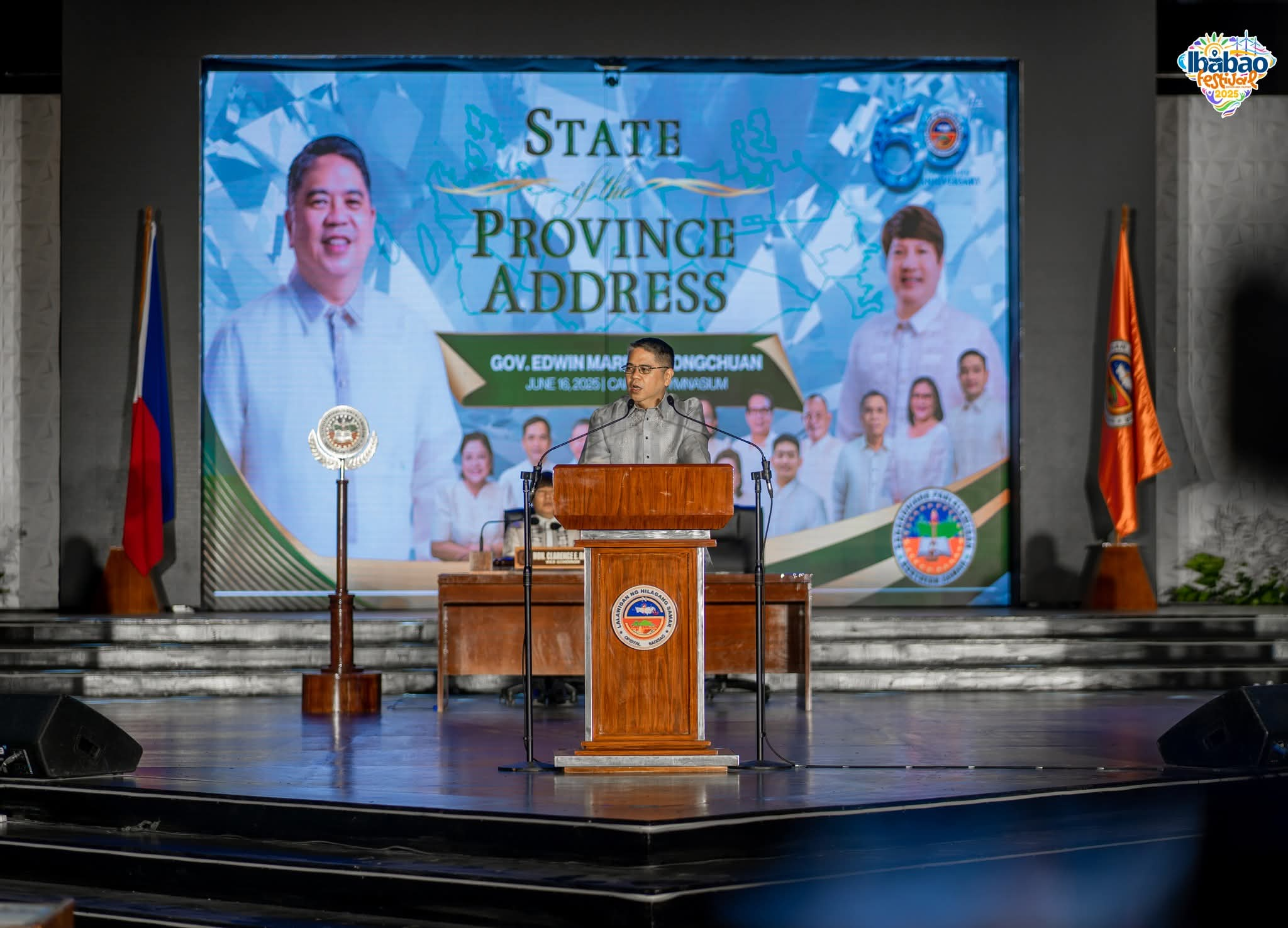by Miriam G. Desacada
Catarman N Samar–Northern Samar Governor Edwin Ongchuan delivered his State of the Province Address (SOPA) on Monday (June 16) at the Capitol in Catarman.
In what felt like both a comprehensive report and a heartfelt farewell, Ongchuan delivered his final SOPA with a tone reminiscent of a valedictory speech. While methodically highlighting the accomplishments of his 6-year administration—from infrastructure development and health care improvements to education and livelihood programs—the outgoing governor spoke with deep emotion and gratitude, giving recognition to all who stood by and worked with him throughout his term.
The SOPA reflected the governor’s personal journey and unwavering devotion to public service, as he traced this devotion back to his late father whose example of public service instilled in him a profound sense of duty and love for Northern Samar.
As he transitions from provincial leadership to his new mandate—which is actually a return to his previously held office—-as representative of the 2nd District, Ongchuan assured his constituents that he carries with him not only the trust they have given him, but also the wisdom gained from leading the province.
His SOPA left the audience not only informed but also deeply moved, as he reaffirmed his commitment to continue serving Northern Samar and its people, even from the halls of Congress.
The governor gave full details of the various accomplishments of the province under his administration, thru his signature development framework—under the acronym PROGRESS:
P for Pro-poor programs, economic and agro-industrial development; R for Roadworks, and other infrastructure projects; O for Opportunities for work, livelihood and employment; G for Good governance; R for Resiliency and peace; E for Education and youth development; S for Social welfare, health and nutrition; and S for Sustainable tourism, and natural resources management.
In reporting his accomplishments, Ongchuan cited the agriculture and fishery modernization plan for the implementation of modern infrastructure, education, funding, and technology assistance toward sustainable agriculture and fishery.
On economic development and investment promotion, Northern Samar proved its excellence in this field when it was recognized nationally as the best provincial partner in the advancement of micro, small, and medium enterprises (MSMEs).
He said MSMEs contributed almost half of the province’s gross domestic product (GDP), after being exposed in trade fairs, and other similar platforms that widened their market and promoted their products resulting in a strong economic foundation in Northern Samar.
On renewable energy development, Ongchuan spearheaded the establishment of wind energy operators (both inland and offshore), and the tidal energy project, which both earned the province Presidential Awards from Malacanang.
The governor said he intensified infrastructure projects to meet the primary needs of the community. He reported that his administration was able to build nine bridges, 17 farm-to-market roads, 23 classrooms, four health stations, 38 evacuation centers, seawalls and river controls, four solar street lights projects, and 20 road repair and improvement projects, including those in remote areas that resulted in shorter travel time and open trade and employment opportunities.
On governance, Ongchuan took pride that, for two consecutive years, the provincial government earned the Seal of Good Local Governance (SGLG) awards from the DILG, achieving the norms of truthful, transparent, and sympathetic administration. The provincial government hurdled tests—from financial administration to health responsiveness, from disaster preparedness to tourism, culture, and arts.
Ongchuan said Northern Samar’s fiscal standing have been strong. For the first time in six years, he said, provincial assets hit P9.38-billion, provincial debts dropped to only P1.14-billion—the lowest since 2019—while net worth or equity of Northern Samar soared to P7.68-billion, a confirmation that the province has a strong and stable financial health.
Income-wise, the province earned P2.36 billion last year, exceeding the P1.92 billion it had in 2023; expenditures rose to P2.08 billion to finance many programs, projects, and services, but Ongchuan said he made it sure that financial administration was prudent and effective to promote an orderly, responsible and sustainable government.
Ongchuan said the capability of LGUs on climate change mitigation and natural resources preservation has been strengthened. “This is part of our broad vision to have a stable, safe, and climate-resilient Northern Samar,” he said.
To foster enduring peace with real reintegration of former rebels—aside from millions in financial aid, and livelihood assistance—Ongchuan launched Kauswagan Village, the first ever peace and prosperity community in the entire Samar island, which served as a community model for a reformed life of the ex-rebels and even the informal settlers.
On education infrastructure, the government was able to construct and repair school buildings. Qualified students were also trained in journalism and sports, with the government spending more than P12 million to finance the participation of student-athletes in various sports events, as well as to fund the participation of student writers in regional press conferences to mold them into future journalists.
A touching story that Ongchuan narrated, in line with the implementation of policies to address the rights and welfare of the marginalized sector, is his landmark program, the Kauswagan Caravan, which he said is closest to his heart.
“The recently held Kauswagan Caravan—a program that is closest to my heart—was born from a simple wish—bring government services to every Nortehanon, notwithstanding the distance of their barangay. Every time we reach a remote area, I saw for myself the hardship of our people who were not able to enjoy the services they are supposed to have,” said the governor.
“Because of this, I pushed for the Kauswagan Caravan, a multi-sectoral convergence initiative that is now done at 189 barangays in 22 towns, serving more than 250,000 constituents. With the help of 37 national agencies, six NGOs, and 129 private partners, we were able to bring services on medical, dental, legal, livelihood, agricultural, and many more, directly to these people.
“One part of the caravan that I will never skip is what we called as ‘deep dive’—my personal visit to pre-selected families in a particular barangay. Accompanying me in this visit is my wife Bles, who has a ready ear to their lamentations, and a loving hug as she helped in giving them clothes, toys, and hygiene kits that she prepared earlier herself. Her presence always provided warmth and happiness to every family we personally visited,” Ongchuan said.
“In those personal visits, we heard and knew better the true stories of our fellow Nortehanons—their dreams, challenges, and hope drawn from a government that is ready to listen to their voices. This Deep Dive, together with focus group discussions during post-caravan planning, is done for us to be sure that their wishes will be included in our programs that will truly address their needs.
“Kauswagan Caravan is not just a program but a resolve that a service is not a matter to be waited for, but to be brought directly to the people instead. Government must not only be heard, but to be felt by the people,” said Ongchuan.
In support of grassroots health services, “we strengthen the roster of barangay health workers, train them more, expand their workforce, with the aid of social workers—a testament of the provincial government’s mission to provide quality, humane, and fast social services to every Nortehanon,” he said.
The province succeeded in hosting international cruise shore excursions to Capul, Biri, and Lalaguna Mangrove Eco-Park, broadening the exposure of Northern Samar as a tourist destination in the global market. Another tourism highlight for this year was the launching of Northern Samar as Aspiring UNESCO Global Geopark with the formal declaration of Biri Rock Formations as a National Geological Monument.
Ongchuan said he is grateful to the national government agencies for their assistance accorded to our province and citizens. “We shall be conducting the what we call as convergence of national agencies with the provincial government wherein we discuss every project and aid coming from the national government so we could implement them properly.”
Onchuan finally announced: “This coming June 19, we shall celebrate the 60th founding anniversary of our beloved Northern Samar—a province that was once ignorable to many Filipinos, but is now an appealing place for the national government, tourists, and investors.” With it is the Ibabao Festival 2025 celebration, which features Northern Samar an attractive destination for investors, rich with business opportunities in agriculture, tourism, renewable energy, and many more.
The governor then expressed gratitude and paid tribute to all who partnered with his administration in making changes to the province. “The positive outcomes we have now are the fruits of our unity and collective stand, a fitting testament to our anniversary theme: Strength in unity, towards a legacy of resilience and progress.” he said. —-Miriam G. Desacada

